
Ultimate Guide to the Best Sightseeing Spots Near Osaka and Umeda Stations!
- Written by: WESTPLAN
Osaka Station is a useful travel hub that grants convenient access to many different sightseeing spots in the Kansai region, such as Dōtonbori, Kyoto, Kobe, and Nara. It helps that there are plenty of places to do shopping in and around the station as well! The thing is, Osaka Station doesn't just serve the JR Lines. The nearby Umeda Station is connected to the metropolitan subway, and if you intend to travel on one of other many private railways passing through the city, you'll have to make use of Osaka-Umeda Station. Although all three stations are within walking distance from each other, changing trains between them can be a little overwhelming if it's your first time there. This guide will give a thorough explanation about these Osaka transport hubs and help you to reach those places of interest you've been planning to visit with ease and peace of mind.
MR. AEKALAK CHIAMCHAROEN / Shutterstock.com
- Table of Contents
-
- The difference between Osaka, Umeda, and Osaka-Umeda Stations
- Going to Universal Studios Japan? Osaka Station on the JR Lines is your best bet
- For Osaka Castle, choose Osaka Station on the JR Lines; Nishinomaru Garden, an excellent sakura viewing spot, go to Higashi-Umeda Station on the Osaka Metro
- For a smoother journey to Dōtonbori, set off from Umeda Station or Nishi-Umeda Station on the Osaka Metro
- To go to Kyoto, either set off from Osaka Station on the JR Lines or Osaka-Umeda Station on the Hankyu Lines
- What about Kobe? Either use Osaka Station on the JR Lines, Osaka-Umeda Station on the Hankyu Lines, or Osaka-Umeda Station on the Hanshin Lines
- Nara: Osaka Station on the JR Lines wins this one
- Learning to make full use of all three major transport hubs in Osaka is worth the effort!
- Top-rated hotels near Osaka Station
The difference between Osaka, Umeda, and Osaka-Umeda Stations
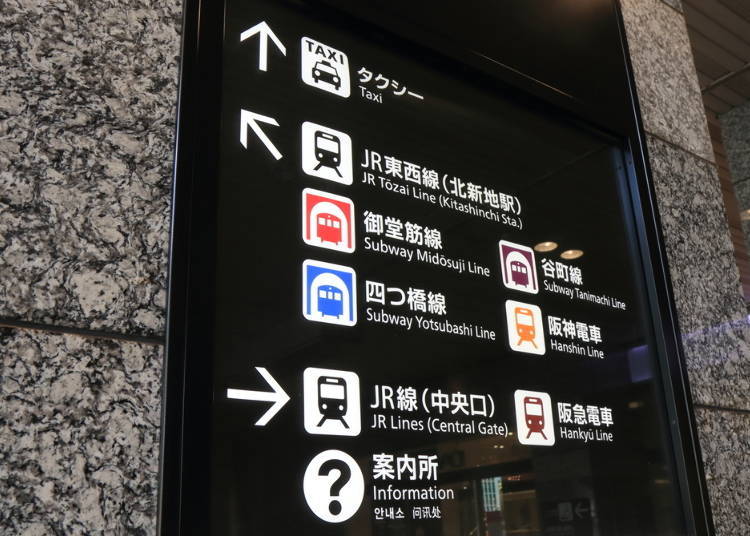
The largest train station in Osaka City is Osaka Station, and it is conveniently located in the center of northern Osaka, where shopping spots and eating areas abound.
It sounds simple enough, so here's where things get a little complicated: The name of this station changes depending on which train you're on. For example, on JR Lines, the station is called Osaka Station. On the Osaka Metro, it's either Umeda Station, Higashi-Umeda Station, or Nishi-Umeda Station. If you're on the Hankyu or Hanshin private railways, the station is called Osaka-Umeda Station. Nevertheless, once you figure out a strategy for identifying the station names correctly, a lot of great places open up to you, so this is definitely something worth doing if you intend to thoroughly explore the wonderful city of Osaka and the areas around it!
[Main sightseeing spots easily accessible from each station]
JR Osaka Station: Universal Studios Japan, Osaka Castle, Kyoto, Kobe, Nara, nearby Kinki prefectures
Osaka Metro Umeda Station: Dōtonbori, Shinsaibashi, Kuromon Market, Shinsekai
Osaka Metro Higashi-Umeda Station: Nakazakichō, Tennōji, Shitennōji
Osaka Metro Nishi-Umeda Station: Dōtonbori
Hankyu Osaka-Umeda Station: Kyoto, Kobe
Hanshin Osaka-Umeda Station: Kobe, Kōshien
Have you decided on your accommodation yet?
Going to Universal Studios Japan? Osaka Station on the JR Lines is your best bet
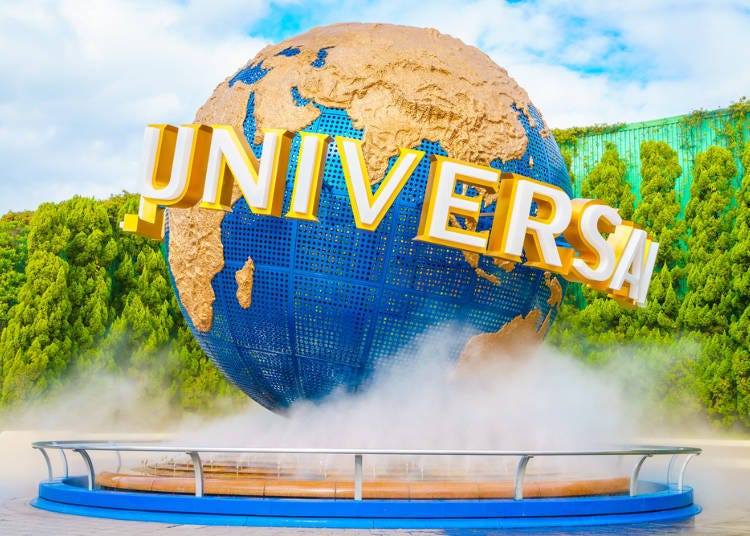
Universal Studios Japan (USJ) is a major tourist destination that you probably have in your itinerary as well. For easy access to this theme park, go to Osaka Station on the JR Lines and from Platform 1, take the Osaka Loop Line's inner loop until Nishi-Kujo Station, then change to a train on the JR Yumesaki Line before finally stopping at Universal Studios Station. This should take about 11 minutes one way, and the total fare will set you back 180 yen.
An alternate way of getting there is the Universal City Sakurajima train that departs from Platform 1 of Osaka Station every 15 minutes or so. This train takes you directly to the station, so there's no need to change trains, making the journey smoother. The fare is also 180 yen.
For Osaka Castle, choose Osaka Station on the JR Lines; Nishinomaru Garden, an excellent sakura viewing spot, go to Higashi-Umeda Station on the Osaka Metro
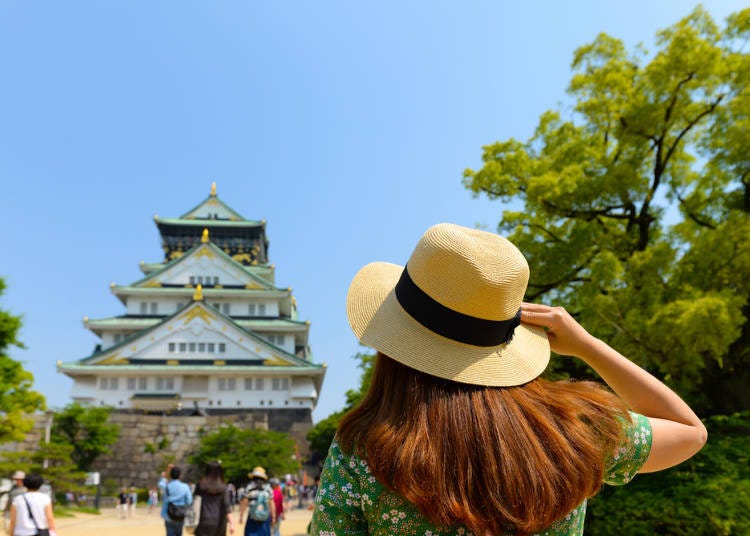
To get to Osaka Castle, there are two main routes you can use: Either go via Osaka Station on the JR Lines or Higashi-Umeda Station on the Osaka Metro.
Shortest/Cheapest Route: Osaka Station on the JR Lines
Head to the Osaka Loop Line's outer loop on Platform 2 to take a train to Osakajokoen Station, which is about 10 minutes and costs 160 yen one way. Once you exit Osakajokoen Station, you'll be greeted by Jo-Terrace Osaka, a building that contains a commercial mall with restaurants and cafes with great food. From here, you can take a slow walk to Osaka Castle's main keep while enjoying a bit of shopping and local food on the fly.

■Going during sakura season? Try Higashi-Umeda Station on the Osaka Metro
Mid-March to early-April is the period when Japan's sakura, or cherry blossoms are in full bloom. West of the main keep of Osaka Castle is Nishinomaru Garden, a well-known sakura viewing spot because of the about 300 someiyoshino sakura trees planted there. If you're traveling to Osaka in spring, therefore, this place will be ideal for an enjoyable stroll.
From Platform 1 of Higashi-Umeda Station on the Osaka Metro, hop onto a train headed for Yaominami. It takes about five minutes to reach Temmabashi Station, the station nearest to Nishinomaru Garden, and the fare is 180 yen one way. The beautiful sakura-studded garden itself will be about a 14-minutes walk from Exit 3 of the station.
For a smoother journey to Dōtonbori, set off from Umeda Station or Nishi-Umeda Station on the Osaka Metro

Dōtonbori is a fun and exciting food paradise where even the streets are lined with stalls selling fantastic takoyaki (octopus balls) and okonomiyaki (Japanese pancakes). For a smoother journey here, set off from Umeda Station or Nishi-Umeda Station on the Osaka Metro.
There are three sub-stations on the Osaka Metro subway in Osaka Station: Umeda Station on the Midosuji Line, Higashi-Umeda Station on the Tanimachi Line, and Nishi-Umeda Station on the Yotsubashi Line. All three stations are connected via an underground street.
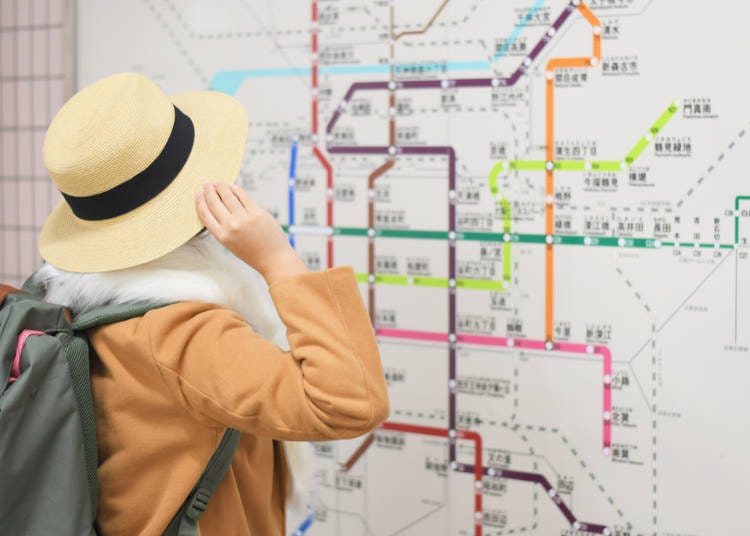
The ceiling of the underground streets around the Osaka Station area are marked with guide signs, so just look up at the signboards if you're not sure where you are. Train routes are also color-coded for easy identification.
* Midosuji Line: Red
Tanimachi Line: Purple
Yotsubashi Line: Blue
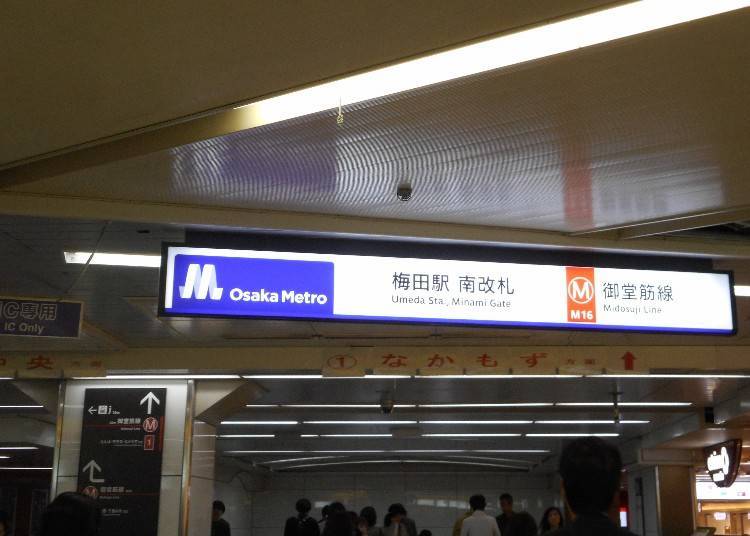
For simplicity, use Umeda Station on the Osaka Metro
Platform 1 of Umeda Station on the Osaka Metro's Midosuji Line will take you to Namba Station in about nine minutes for 230 yen. Come out of Exit 14 and walk for about 14 minutes to reach the famous Dōtonbori Glico Sign.
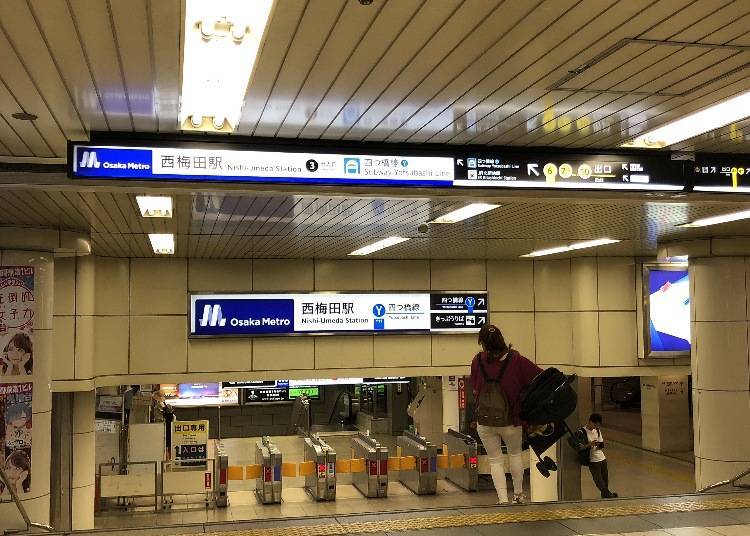
Use Nishi-Umeda Station on the Osaka Metro if you want to avoid crowds
Osaka Metro's Midosuji Line cuts through the city center from north to south and has a high daily ridership, which includes people from all walks of life such as businessmen and tourists. As such, the trains on this line are often quite packed even during off-peak hours.
On that note, trains on the Yotsubashi Line have relatively less riders, so seats should be easy to find as long as it's not the morning or evening rush hour period. It takes about seven minutes to reach Namba Station from Platforms 1 or 2 of Nishi-Umeda Station, and the fare will cost 230 yen one way.

Use the Osaka Metro for Shinsaibashi too!
Shinsaibashi is an excellent place to visit to shop for branded goods, and since it's a short 15-minutes walk away from Dōtonbori, hitting both places at once is a very effective way to make use of limited sightseeing time. That's where Osaka Metro's Midosuji Line comes in handy here. The train from Namba Station to Shinsaibashi Station will only take about two minutes, for a fare of 180 yen.
To go to Kyoto, either set off from Osaka Station on the JR Lines or Osaka-Umeda Station on the Hankyu Lines
There are two main routes to choose from to go to Kyoto from Osaka City. Either set off from Osaka Station on the JR Lines or Osaka-Umeda Station on the Hankyu Lines. Depending on the destination, though, either one may be more efficient than the other. Take some time to look it up and plan well!
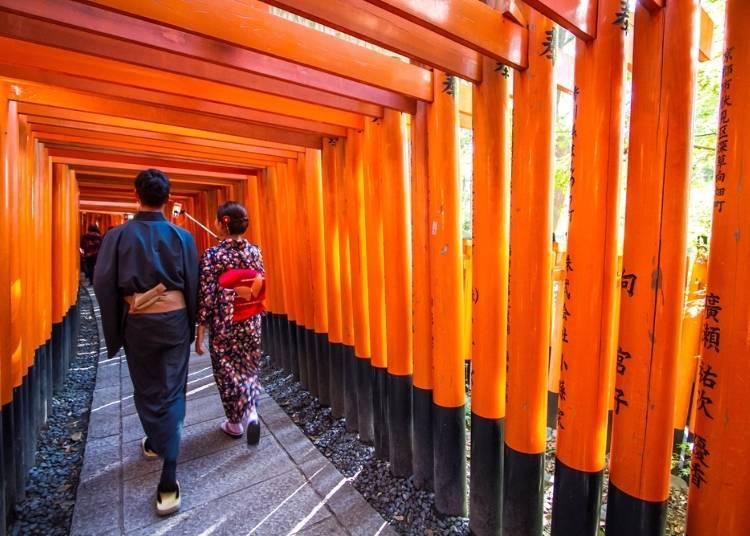
Use the JR Lines for better access to Kyoto Tower or Fushimi Inari Shrine
Platforms 7, 8, 9, and 10 (depends on timing) of Osaka Station on the JR Lines is where you can travel to Kyoto via a Shinkaisoku (Special Express) train on the Kyoto Line. It reaches in about 30 minutes for 570 yen one way. Before boarding, be sure to double check if the train is indeed a Shinkaisoku train. If it's a Kaisoku or regular train instead, you'll be paying the same fare for a longer trip of about 50 minutes because of more stops along the way.
[Major places of interest around Kyoto Station]
Kyoto Tower, Higashi Hongan Shrine, Nishi Hongan Shrine, Tō Shrine, Fushimi Inari Shrine (Inari Station on the Nara Line from Kyoto Station, about 5 minutes for 150 yen one way), etc.

■Hankyu is better for Gion or Arashiyama
Looking to enjoy a Kyoto-esque streetscape while basking in the atmosphere of olden Gion or majestic Arashiyama? The ancient city of Kyoto is much easier to access via Osaka-Umeda Station on the Hankyu Lines.

To reach the Gion area, board a Limited Express on the Hankyu Kyoto Main Line to Kyoto-Kawaramachi Station. The trip will take about 43 minutes and costs 400 yen one way. Come out from Exit 1B of the station and walk for about 10 minutes to reach one of Gion's most well-known landmarks, Yasaka Shrine.
[Major sightseeing spots near Gion]
Yasaka Shrine, Yasaka Pagoda, Nishiki Market, Hanamikoji Street, etc.
As for the Arashiyama area, take a train to Katsura Station on the Hankyu Kyoto Main Line, then switch to the Hankyu Arashiyama Line and head for Arashiyama Station. In all, this will take about 40 minutes and 400 yen one way. From here, the Togetsu Bridge which showcases the epic scenery of Arashiyama is only a 7-minutes walk away.
[Arashiyama major sightseeing spots]
Togetsu Bridge, Arashiyama Bamboo Grove, Arashiyama Monkey Park, Tenryū Temple, etc.
What about Kobe? Either use Osaka Station on the JR Lines, Osaka-Umeda Station on the Hankyu Lines, or Osaka-Umeda Station on the Hanshin Lines

To get to Kobe from Osaka, there are three stations you can consider using: Osaka Station on the JR Lines, Osaka-Umeda Station on the Hankyu Lines, or Osaka-Umeda Station on the Hanshin Lines.
Fastest route: Osaka Station on the JR Lines
From Osaka Station on the JR Lines, hop aboard a Shinkaisoku train on the Kobe Line from either Platform 3, 4, 5, or 6 (depends on timing) and you'll be there in about 20 minutes for 410 yen one way. Again, double check to ensure that it's a Shinkaisoku train, because mistakenly boarding an express or regular train means paying the same fare to reach in double the time, as the train will stop at more stations along the way.
Cheapest route: Hankyu or Hanshin Lines
If you take a Hankyu Kobe Main Line Limited Express or a Hanshin Main Line Limited Express from Osaka-Umeda Station on the Hankyu or Hanshin Lines, you'll reach Kobe's Sannomiya Station on the Hankyu or Hanshin Lines in about 30 minutes for 320 yen one way. This is about 10 minutes more than the Shinkaisoku on the JR Lines, but 90 yen cheaper, so take your pick according to your travel preference.
The fare and time needed to reach the destination is the same whether on a Hankyu or Hanshin train, so carefully consider which train's departure schedule fits yours best!
Nara: Osaka Station on the JR Lines wins this one
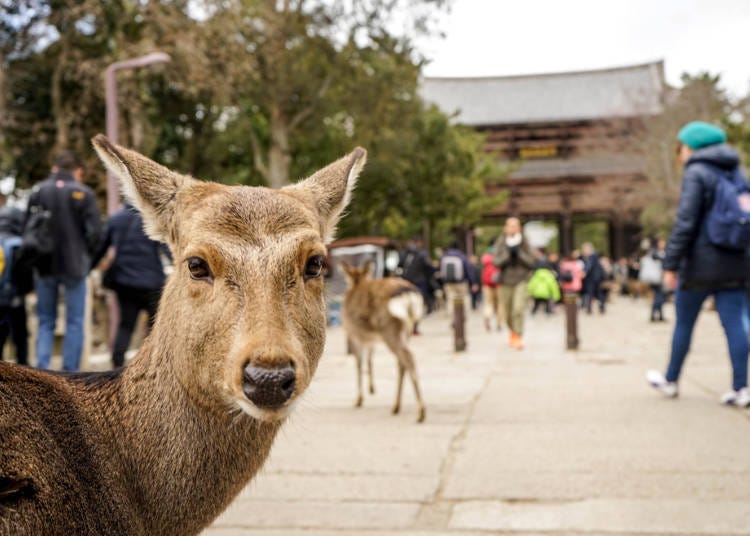
To go to Nara, set off from Osaka Station on the JR Lines, because there's a train that goes directly to Nara Station from there. Either that, or change trains to go to the Kintetsu Nara Station instead. Kintetsu Nara Station is located near a bustling shopping street. Kōfuku Temple is a short 10-minutes walk away, and the station is also near Nara Park, where the prefecture's internationally famous deer reside, making the station a convenient base to use for sightseeing in the area.
That said, it takes about 15 minutes to walk from Nara Station to Kintetsu Nara Station, so we do recommend considering a taxi if you or someone in your travel group is not able to walk for long.
Shortest route: Direct access to Nara Station on the JR Lines
Hop on a Yamatoji Line express train from Platform 1 of Osaka Station on the JR lines to reach Nara Station on the JR Lines in about an hour for 810 yen one way. Since there's no need to change trains for this route, it's the shortest and smoothest way to get to your destination.
Cheapest route: Change to a Kintetsu Railway train
Board a train on the JR Osaka Station Loop Line's inner loop on Platform 1 heading towards Tsuruhashi Station. From there, change to a Kintetsu Railway Kintetsu Nara Line Rapid Express to reach Kintetsu Nara Station in about an hour for 680 yen one way. There's a bit of a hassle due to the changing of trains, but it's almost the same amount of time as the direct train for 130 yen less.
Learning to make full use of all three major transport hubs in Osaka is worth the effort!
At first glance, having three major stations in close vicinity with each other sounds like a complicated affair, but their collective presence offers an ideal way to gain easy access to most major Kansai hotspots. If you set up base near Osaka or Umeda Station, it opens up a lot of choices for you in both Osaka City and nearby places like Kyoto, Kobe, and Nara. The Shinkansen (bullet train) also runs through Osaka, which you can use to reach farther places like Tokyo or Hiroshima within a mere hours. We highly recommend learning how to navigate the Osaka and Umeda train stations so as to fully maximize your enjoyment in the Kansai region and enhance the quality of your trip to Japan!
English translation by: Huimin Pan
Text by:WESTPLAN
Top-rated hotels near Osaka Station
-

-
Address
3-60 Ofukacho, Kita-ku, Osaka-shi, Osaka, 530-0011
View Map -
Nearest Station
Nakatsu Station (Hankyu-kobe Main Line / Hankyu-takarazuka Main Line)
8 minutes on foot
-
Address
3-60 Ofukacho, Kita-ku, Osaka-shi, Osaka, 530-0011
-

-
Address
1-4-26 Dojimahama, Kita-ku, Osaka-shi, Osaka, 530-0004
View Map -
Nearest Station
Watanabebashi Station (Keihan-nakanoshima Line)
5 minutes on foot
-
Address
1-4-26 Dojimahama, Kita-ku, Osaka-shi, Osaka, 530-0004
-

-
Address
Kita-ku, Nakazakinishi, 3-1-4, Osaka, Osaka, 530-0015
View Map -
Nearest Station
Nakazakicho Station (Tanimachi Line)
5 minutes on foot
Vacancy search, reservation
-
Please enquire directly about rates.
Check with our partner site as the latest rates, rate details, and guest room requirements may vary.
-
Address
Kita-ku, Nakazakinishi, 3-1-4, Osaka, Osaka, 530-0015
Kiko Matsuda, Keiko Kimura, Risa Tsushi, and a team of female writers familiar with Kansai. We love eating, drinking and traveling! We share fun information based on our experiences.
*Prices and options mentioned are subject to change.
*Unless stated otherwise, all prices include tax.
Popular Tours & Activitiess
Recommended places for you
-

Jukuseiniku-to Namamottsuarera Nikubaru Italian Nikutaria Sannomiya
Izakaya
Kobe, Sannomiya, Kitano
-

Kanzenkoshitsuyakinikutabehodai Gyugyu Paradise Sannomiya
Yakiniku
Kobe, Sannomiya, Kitano
-

Kambei Sannomiyahonten
Yakiniku
Kobe, Sannomiya, Kitano
-

ISHIDAYA Hanare
Yakiniku
Kobe, Sannomiya, Kitano
-
Goods

Yoshida Gennojo-Roho Kyoto Buddhist Altars
Gift Shops
Nijo Castle, Kyoto Imperial Palace
-
Events

Sunflower terminal (Osaka) Terminal 1
Other Sightseeing
USJ, Nanko Port
-
Ad

Experiencing Manga as Culture, Not Just Reading It: Expo 2025 with Rumiko Takahashi
-

Curious About Sake? I Visited a Sake Brewery in Japan and Here's What I Learned
-
Ad

Discover Timeless Beauty: Kimono-en, a Web Magazine Exploring the Spirit of Kimono
-

Everything You Need to Know About teamLab Biovortex Kyoto (2025 Insider Guide)
by: Wemmy Chau
-
Ad

Recharge and Relax with a Healing Getaway at Kamenoi Hotel Toba
-

Best Things to Do and See Around Kyoto & Osaka in September: Events and Festivals in Kansai
Inspiration for Accommodations
-

Spacious Family Hotel in Namba: 20 Comfortable Stays for Family Fun
-

Charming Hotels to Enjoy the Spectacular Views of Arashiyama's Autumn Leaves from Your Room
-

Experience Stunning Views of Osaka Castle from Private Spaces: Top Hotels Near Osaka Castle
-

Recommended by Visitors! Arashiyama's Best-Rated Hotels
-

Family-Friendly Universal Studios Japan Hotel with Excellent Access
-

Enjoy a Comfortable Stay in Osaka! 10 Hotels with Convenient Airport Shuttle Services
-

Top 10 Recommended Hotels Near Namba Station with Great Access
-

Enjoy Night Views from Your Room! Recommended Hotels in Namba Area
-
Ad

Smart Travel in Kyoto: Using Luggage Storage & Delivery Services at Kyoto Station
-

Sightseeing Highlights: Experience the Appeal of Kyoto Geisha Culture
-

Complete Guide to Buying Japanese Medicine in Japan: Phrases and Vocabulary You Need to Know
-

Ippudo Osaka and More: These 5 Ramen Restaurants in Osaka Are Going Viral
by: WESTPLAN
-

Osaka Travel Service Center: So Many Incredibly Convenient Services - in English!
by: WESTPLAN
-

Why Is Osaka So Wildly Popular With Foreign Tourists?
by: WESTPLAN
- #best gourmet Osaka
- #things to do Osaka
- #what to do in kyoto
- #what to bring to japan
- #best gourmet Kyoto
- #new years in Osaka
- #what to buy in nanba
- #Visiting Osaka
- #onsen tattoo friendly arima
- #daiso
- #Visiting Kyoto
- #best japanese soft drinks
- #japanese fashion culture
- #japanese convenience store snacks
- #japanese nail trends














